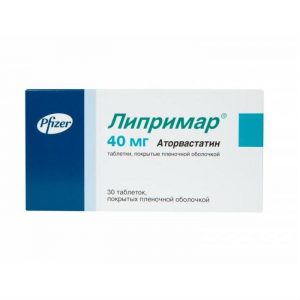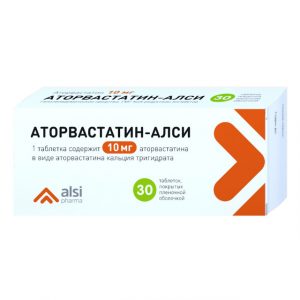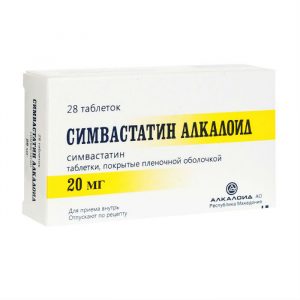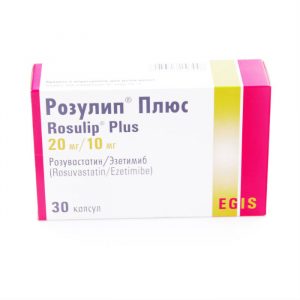Description
Latin name
Simvastatin
release tablet-coated tablets 10 mg and 20 mg.
10 tablets, coated in a white blister of PVC / PVDC / AL. 2 blisters together with instructions for use are placed in a cardboard pack.
packaging 20 pcs
Pharmacological action
The lipid-lowering agent obtained synthetically from the fermentation product Aspergillus terreus is an inactive lactone, undergoes hydrolysis in the body to form a hydroxy acid derivative. The active metabolite inhibits 3-hydroxy-3-methyl-glutaryl-CoA reductase (HMG-CoA reductase), an enzyme that catalyzes the initial formation of mevalonate from HMG-CoA. Since the conversion of HMG-CoA to mevalonate is an early stage in the synthesis of cholesterol, the use of simvastatin does not cause the accumulation of potentially toxic sterols in the body. HMG-CoA is easily metabolized to acetyl-CoA, which is involved in many synthesis processes in the body.
Causes a decrease in plasma levels of triglycerides (TG), low density lipoproteins (LDL), very low density lipoproteins (VLDL) and total cholesterol (in cases of heterozygous familial and non-familial forms of hypercholesterolemia, with mixed hyperlipidemia, when there is an increased risk of cholesterol )
Increases the content of high density lipoproteins (HDL) and reduces the ratio of LDL / HDL and total cholesterol / HDL.
The onset of the manifestation of the effect is 2 weeks after the start of administration, the maximum therapeutic effect is achieved after 4-6 weeks. The effect persists with continued treatment, with the cessation of therapy, the cholesterol content gradually returns to its original level.
Pharmacokinetics
Absorption of simvastatin is high. After oral administration, the maximum plasma concentration is reached after about 1.3-2.4 hours and decreases by 90% after 12 hours. Communication with plasma proteins is about 95%.
Metabolized in the liver, has a first pass effect through the liver (hydrolyzed to form an active derivative: beta-hydroxy acids, other active and inactive metabolites were found). The half-life of active metabolites is 1.9 hours.
It is excreted mainly by the intestines (60%) as metabolites. About 10-15% is excreted by the kidneys in an inactive form.
Indications
Hypercholesterolemia:
primary hypercholesterolemia (type IIa and IIb) with ineffective diet therapy with low cholesterol and other non-pharmacological measures (physical activity and weight loss) in patients with an increased risk of coronary atherosclerosclerosis and hyperplasma not adjusted by a special diet and physical activity.
Coronary heart disease: to prevent myocardial infarction, to reduce the risk of death, reduce the risk of cardiovascular disorders (stroke or transient ischemic attacks), slow the progression of coronary atherosclerosis, and reduce the risk of revascularization procedures.
Use in children and adolescents with heterozygous familial hypercholesterolemia: the use of simvastatin at the same time as a diet is indicated to reduce the increased concentration of total cholesterol, LDL cholesterol, TG, apo B in young men 10-17 years old and in girls 10-17 years old after at least 1 year after menarche (first menstrual bleeding) with heterozygous familial hypercholesterolemia.
Contraindications
Hypersensitivity to simvastatin or other components of the drug, as well as other statin drugs (HMG-CoA reductase inhibitors) in the history of
liver disease in the active phase, a persistent increase in the activity of liver transaminases of an unclear etiology
skeletal muscle disease (myopathy)
simultaneous use with strong inhibitors of itrazone azoformol , ketoconazole, voriconazole, posaconazole, HIV protease inhibitors, boceprevir, telaprevir, erythromycin, clarithromycin, telithromycin, nefazodone and cobicistat preparations)
with comorbid treatment with gemfibrozil, cyclosporine or danazol
age of 18 years (except for children and adolescents 10-17 years, with heterozygous familial hypercholesterolemia) (see. section Indications for use )
use during pregnancy and during breastfeeding
lactose intolerance, lactase deficiency or glucose-galactose malabsorption (the drug contains lactose).
With caution: patients with alcohol abuse, a history of liver disease, patients after organ transplantation who are being treated with immunosuppressive drugs (due to the increased risk of rhabdomyolysis and renal failure), the simultaneous use of dronedarone, ranolazine, fibrates (except for gemfibrozil and fenofibrate) amiodarone, slow calcium channel blockers (verapamil, diltiazem, amlodipine), lomitapide (the risk of myopathy and rhabdomyolysis increases) patients with chronic renal severe sufficiency (creatinine clearance less than 30 ml / min) of the condition, which can lead to the development of severe renal failure, such as arterial hypotension, severe acute infectious diseases, severe metabolic and endocrine disorders, water-electrolyte imbalances, surgical interventions (including dental) or injuries patients with diabetes patients with decreased or increased tone of skeletal muscles of an unclear etiology of epilepsy.
Use during pregnancy and lactation
Simvastatin may have an adverse effect on the fetus and is contraindicated in pregnant women. There are several reports of the development of abnormalities in newborns whose mothers took Simvastatin.
Women of reproductive age taking Simvastatin should avoid conception. The use of simvastatin is not recommended in women of childbearing age who do not use contraceptives. If pregnancy does occur during treatment, Simvastatin should be canceled, and the woman should be warned of a possible danger to the fetus.
There are no data on the excretion of simvastatin with breast milk. If necessary, the appointment of simvastatin during breastfeeding should be considered, that many drugs are excreted in breast milk, and there is a risk of severe reactions, therefore breastfeeding while taking the drug is not recommended
Composition
One 20 mg film-coated tablet contains the active substance: simvastatin 20 mg
excipients: lactose – 148.5 mg, pre-gelatinized starch – 20.0 mg, microcrystalline cellulose – 10.0 mg, talc (magnesium hydrosilicate) – 2.0 mg, magnesium stearate – 1.5 mg, butyl hydroxyanisole – 0.04 mg shell: hyprolose (hydroxypropyl cellulose) – 1.65 mg, hypromellose – 1.65 mg, titanium dioxide E-171 – 1.5 mg, talc (magnesium hydrosilicate) – 0.6 mg.
Dosage and administration of
Before starting treatment with simvastatin, a standard hypocholesterol diet should be prescribed to the patient, which must be followed throughout the course.
Simvastatin should be taken orally 1 time per day in the evening, with plenty of water.
The time of taking the drug should not be associated with a meal.
The recommended dose of the drug simvastatin for the treatment of hypercholesterolemia varies from 5 to 80 mg once a day in the evening. The recommended starting dose for patients with hypercholesterolemia is 10 mg. The maximum daily dose is 80 mg.
Changes (selection) of the dose should be carried out at intervals of 4 weeks. In most patients, the optimal effect is achieved when taking the drug in doses up to 20 mg per day.
In patients with homozygous hereditary hypercholesterolemia, the recommended daily dose of Simvastatin is 40 mg once daily in the evening or 80 mg in three divided doses (20 mg in the morning, 20 mg in the afternoon and 40 mg in the evening).
In the treatment of patients with coronary heart disease (CHD) or a high risk of developing coronary heart disease, effective doses of the drug simvastatin are 20-40 mg per day. Therefore, the recommended initial dose in such patients is 20 mg per day. Changes (selection) of the dose should be carried out at intervals of 4 weeks, if necessary, the dose can be increased to 40 mg per day. If the LDL content is less than 75 mg / dl (1.94 mmol / L), the total cholesterol content is less than 140 mg / dl (3.6 mmol / L), the dose should be reduced.
In elderly patients and in patients with mild or moderate renal failure, changes in the dosage of the drug are not required.
In patients with severe chronic renal failure (creatinine clearance less than 30 ml / min), the maximum recommended dose of Simvastatin should not exceed 10 mg per day.
Use in children and adolescents 10-17 years old with heterozygous familial hypercholesterolemia
Recommended starting dose is 10 mg per day in the evening. The recommended dosage regimen is 10-40 mg per day, the maximum recommended dose is 40 mg per day. Dose selection is carried out individually in accordance with the goals of therapy.
Concomitant therapy
Simvastatin is effective both as monotherapy and in combination with bile acid sequestrants (see the section Interaction with other drugs ).
In patients taking Simvastatin concomitantly with fibrates, except for gemfibrozil (see section “Contraindications”) or fenofibrate, the maximum recommended dose of simvastatin is 10 mg per day.
With the simultaneous use of the drug with dronedarone, the dose of simvastatin should not exceed 10 mg per day.
With the simultaneous use of the drug with amiodarone, amlodipine, diltiazem, verapamil, ranolazine, the dose of simvastatin should not exceed 20 mg per day.
With the simultaneous use of the drug with lomitapide, the daily dose of simvastatin should not exceed 40 mg (see section “Interaction with other drugs”).
Side effects
Frequency of side effects: very often ( 1/10), often ( 1/100, but <1/10), infrequently ( 1/1000, but <1/100), rarely ( 1/10000, but <1/1000), very rarely (<1/10000), including individual reports, the frequency has not been established (cannot be estimated based on available data) From the digestive system: rarely – abdominal pain, constipation, flatulence , dyspepsia, nausea, vomiting, diarrhea, pancreatitis, hepatitis / jaundice is very rare – fatal and nonfatal liver failure. On the part of the nervous system: rarely – asthenic syndrome, headache, dizziness, peripheral neuropathy, paresthesia very rarely – sleep disturbances, including insomnia and “nightmare” dreams, memory impairment, frequency not established – depression. Rare post-registration reports of cognitive impairment have been received (for example, various memory impairments – forgetfulness, memory loss, amnesia, confusion) associated with the use of statins. These cognitive impairments were reported with all statins. Messages were generally classified as frivolous, with varying durations until the onset of symptoms (from 1 day to several years) and their resolution time (median 3 weeks). Symptoms were reversible and disappeared after withdrawal of statin therapy. Allergic and immunopathological reactions: rarely – hypersensitivity syndrome developed, which manifested itself as angioedema, lupus-like syndrome, polymyalgia rheumatica, dermatomyositis, vasculitis, thrombocytopenia, eosinophilia, arrhythmia, erythrocytosis, erythrocytes, (erythrocytes, (erythrocytes, hot flashes of blood to the skin of the face, shortness of breath and general weakness. From the skin: rarely – skin rash, itching, alopecia. From the musculoskeletal system: rarely – myopathy (including myositis), rhabdomyolysis with or without acute renal failure, myalgia, muscle cramps, frequency not established – tendinopathy, possibly with tendon rupture. Very rare reports have been received of the development of immune-mediated necrotizing myopathy (autoimmune myopathy) due to statin intake, which is characterized by weakness of the proximal muscles and increased serum creatine phosphokinase (CPK), which persist despite the cancellation of statin treatment. A muscle biopsy results in necrotizing myopathy without significant inflammation. Improvement is observed with immunosuppressant therapy. Laboratory indicators: rarely – increased activity of “liver” transaminases, alkaline phosphatase, creatine phosphokinase. An increase in glycosylated hemoglobin (HbAlc) and fasting serum glucose concentrations have been reported with statins, including simvastatin. Other: rare – anemia, frequency not established – erectile dysfunction, sexual dysfunction, gynecomastia, interstitial lung disease. Drug Interaction Contraindicated combinations of medicines Contraindicated with the following medicines is contraindicated. Strong CYP3A4 isoenzyme inhibitors. Simvastatin is metabolized by the CYP3A4 isoenzyme but does not inhibit the activity of this isoenzyme. This suggests that simvastatin intake does not affect the plasma concentration of CYP3A4 isoenzymes. Strong CYP3A4 isoenzyme inhibitors increase the risk of myopathy by reducing the rate of excretion of simvastatin. Co-administration of potent CYP3A4 isoenzyme inhibitors (eg, itraconazole, ketoconazole, posaconazole, voriconazole, erythromycin, clarithromycin, telithromycin, HIV protease inhibitors, boceprevir, telaprevir, nefazodone, drugs containing kobicistat) and simvastatin are contraindicated (see Contraindications sections). Gemfibrozil, cyclosporin or danazol. (See Contraindications Special Instructions, Myopathy / Rhabdomyolysis). Interaction with other medicines Other fibrates. The risk of myopathy increases with the use of simvastatin with gemfibrozil (see Contraindications) and other fibrates (except fenofibrate). These hypolipidemic agents may cause myopathy in monotherapy. With simultaneous use of simvastatin with fenofibrate, the risk of myopathy did not exceed the risk of monotherapy with each drug (see Contraindications Special Instructions, Myopathy / Rhabdomyolysis). Amiodarone. The risk of myopathy / rhabdomyolysis is increased when co-administered with amiodarone with simvastatin. In a clinical trial, the incidence of myopathy in patients receiving Simvastatin 80 mg and amiodarone at the same time was 6% (see section Method of administration and dose Special instructions , Myopathy / Rhabdomyolysis). Blockers of “slow” calcium channels. The risk of developing myopathy / rhabdomyolysis is increased by concomitant use of verapamil, diltiazem or amlodipine with simvastatin (see section Method of administration and dosage Special instructions , Myopathy / rhabdomyolysis). Lomitapid. The risk of myopathy / rhabdomyolysis may be increased with the concomitant use of lomitapid with simvastatin. sections “Method of administration and dose” “Special instructions”, Myopathy / Rhabdomyolysis). Moderate CYP3A4 isoenzyme inhibitors (eg, dronedarone). The concomitant use of drugs with moderate inhibitory activity against the CYP3A4 isoenzyme and simvastatin, especially at higher doses, may increase the risk of myopathy (see Special Instructions, Myopathy / Rhabdomyolysis). Simvastatin co-administration with moderate CYP3A4 isoenzyme inhibitors may require a reduction in simvastatin dose. Ranolazine (a moderate CYP3A4 isoenzyme inhibitor). Concomitant use of ranolazine and simvastatin may increase the risk of myopathy (see Special Instructions, Myopathy / Rhabdomyolysis). Simvastatin and ranolazine may require a reduced dose of simvastatin when co-administered. OATP1B1 transport protein inhibitors. Simvastatin hydroxy acid is a substrate of the transport protein OATP1B1. Concomitant administration of OATP1B1 transport protein inhibitors and simvastatin may lead to increased plasma concentrations of simvastatin hydroxy acid and increased risk of myopathy (see Contraindications, Special Instructions, Myopathy / Rhabdomyolysis). Fusidic acid. Co-administration of fusidic acid and simvastatin may increase the risk of myopathy (see Special Instructions, Myopathy / Rhabdomyolysis). Nicotinic acid (not less than 1 g / day). With the simultaneous use of simvastatin and nicotinic acid in lipid-lowering doses (at least 1 g / day), cases of myopathy / rhabdomyolysis have been reported (see section Special instructions , Myopathy / rhabdomyolysis). Colchicine. When colchicine and simvastatin are used in patients with renal insufficiency, cases of myopathy and rhabdomyolysis have been reported. In combination therapy with these drugs, such patients should be closely monitored. Non-specific anticoagulants (coumarin derivatives). Simvastatin at a dose of 20-40 mg per day potentiates the effect of coumarin anticoagulants: prothrombin time, defined as the International Normalized Ratio (INR), increases from baseline 1.7 to 1.8 in healthy volunteers and from 2.6 to 3.4 y patients with hypercholesterolemia. In patients receiving coumarin anticoagulants, prothrombin time should be determined prior to initiation of simvastatin therapy, and frequently enough during the initial treatment period to exclude significant changes in this indicator. Once a stable MNO rate is reached, its further determination should be made at intervals recommended for the control of patients receiving anticoagulation therapy. Regular measurement of prothrombin time is also recommended when changing the dose of simvastatin or after withdrawal. In patients not receiving anticoagulants, simvastatin therapy was not associated with the occurrence of bleeding or changes in prothrombin time. Digoxin. Increase in the concentration of digoxin in the blood plasma is possible. Bile acid sequestrants. Colestyramine and colestipol reduce the bioavailability of simvastatin The use of simvastatin is possible 2 hours before or 4 hours after administration of these drugs, with an additive effect. Other Types of Interaction Grapefruit juice contains one or more components that inhibit the CYP3A4 isoenzyme and may increase blood plasma concentrations of CYP3A4 isoenzyme metabolites. When using the juice in the usual amount (1 glass 250 ml per day), this effect is minimal (there is an increase in the activity of HMG-CoA reductase inhibitors by 13% when assessed by AUC) and has no clinical significance. However, the use of grapefruit juice in large volumes significantly increases the activity of HMG-CoA reductase inhibitors in blood plasma. Therefore, the use of grapefruit juice in simvastatin therapy should be avoided (see Special Instructions, Myopathy / Rhabdomyolysis). Overdose No specific symptoms were identified in any of the several known cases of overdose (maximum accepted dose of 450 mg). Treatment: induce vomiting, accept activated charcoal. Symptomatic therapy. Functions of the liver and kidneys, the level of CPK in serum, should be monitored. In the development of myopathy with rhabdomyolysis and acute renal failure (a rare but severe side effect), immediately discontinue the drug and introduce diuretic and sodium bicarbonate to the patient (intravenous infusion). If necessary, hemodialysis is indicated. Rhabdomyolysis can cause hyperkalemia, which can be eliminated by intravenous administration of calcium chloride or gluconate calcium, glucose infusion with insulin, use of potassium ion exchangers, or in severe cases, using hemodialysis. Storage conditions At a temperature of 15 to 25 ° C. Keep out of the reach of children! The Expiration of is 3 years. Deystvuyuschee substances Simvastatin dosage form dosage form tablets




